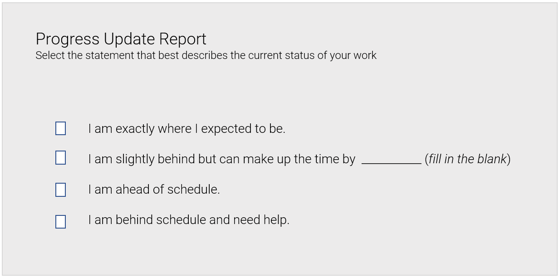Project management is a discipline concerned with progress. Project managers and project stakeholders need up-to-date, verifiable, and trustworthy information on progress and status. Without accurate information, they can not guide, manage or take any corrective action. Project managers can’t fix what they don’t see.
On a regular basis, project managers and stakeholders should be provided with status reports that accurately measure how things are going.
While each stakeholder or stakeholder group may need a different format or view to the same data, the common measure of progress is percent complete. Progressing your activities and projects correctly is a key to taking control of your project and ensuring projects complete on time. Status updates at regular intervals let you keep your finger on the pulse of progress. Are you ahead of schedule, or are you slipping?
Your project needs a schedule.
Plan before starting anything. Before you can progress your project in any meaningful way, you need a schedule. A schedule that clearly shows your minor and major deliverables, all the tasks and steps required to complete these deliverables, and finally, how to complete the entire project. Make sure your schedule is resource loaded. Without a resource plan, you cannot tell what resources are needed and when.
Once an agreed-upon schedule is in place, set it as the baseline for comparing actual and planned progress.
Only now can work commence and progress be reported.
Here you can read our previous blogs on baseline and scheduling best practise:
Why Your Baseline is Essential in Project Management (safran.com)
12 Critical Project Scheduling Best Practices (safran.com)
Or download this guide on five principles of project success:
*Download "The Five Immutable Principles of Project Success" by clicking the image
Do you know how to measure progress?
The execution process is the beat of the project. This means that the status update is performed repeatedly and regularly on a daily, weekly, or monthly basis. A quicker beat will give you better information on achievements and trends. It's this beat that gives you actionable information and insights on a time scale that allows the project manager to take corrective actions to stay on schedule, on budget, and technical compliance.
No matter the duration of the performance assessment, measures of progress must be meaningful to the team and all stakeholders. Measures should also be reliable, testable, and verifiable. A measure of work accomplished using physical percent complete (% Complete) is mandatory. Avoid using elapsed time or actual expenditure as measures of progress. Elapsed time only tells you that time has passed. Actual expenditure only tells you that a certain number of people has booked hours or costs on your project.
Avoid poor status reporting
Over the years, we have seen several examples of failed planning and wrong measures of progress. Technically challenging projects have been planned with only single delivery milestones, with due dates as much as three years from now. These schedules are unable to show any details on the required tasks or steps to achieve the milestones. As the schedule and activities are undefined, you cannot resource load the schedule and not ensure you have the right resources available. Neither can you, at any point in time, tell how much of the work is completed.
Interestingly, project teams still insist that they are “on schedule”, “ahead of schedule” or “slightly behind schedule” in reaching these milestones. Often, the milestones exist as task lists in spreadsheets with predefined progress statuses like "on schedule," "delayed," "on hold," and "completed." These verbal statuses may be correct, but you have no way of verifying them.
- Due dates have slipped three months, but the team still reports "on schedule."
- The team reports "delayed," but the due date is not updated.
- The team reports on schedule with a due date earlier than the reporting or status date.
- The team reports "on schedule," with a due date set to "to be confirmed." (how do you know that you are on schedule for something that isn't defined?)
If I told you I was ahead of schedule for delivery three years from now and couldn't show you the details, task, and path to achieve that delivery and what work has been done to date, would you trust me? Should you trust me?
However, you can do worse. Below is an example of a progress update report we came across a few years ago.

It doesn't work. It will never give you reliable information.
Don't leave project status to chance
When progress is measured, it is essential to have an agreed-on measure of performance (% Complete) that is defined before work starts. And you need the schedule, showing the tasks required and how you plan to complete your delivery. And finally, when progress is reported stakeholders and project managers should ask their teams: show me the proof? What is done? And what is remaining?
If a project manager has no plan or available resources and if there is no way to measure the progress of the project, the probability of success is zero. There can be no confidence that the project will succeed in getting to done. Meaningful, reliable, and verifiable information is needed.
Using Project management tools like Safran Planner, Safran Project, and Safran Risk can help bring together planning, scheduling, and execution and help projects complete successfully. Using purpose-built software and following best practices of planning and progress reporting is an easy way to re-instate project confidence.
In one of our previous blogs, you can find a few tips on increasing value in project status reports.
How to Increase Value in Project Status Reports (safran.com)




